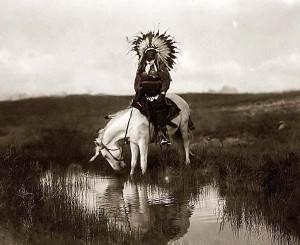Sooner or later, anyone studying Cheyenne ethnohistory will get round to reading George Bird Grinnell’s two volume work on this famous Plains tribe. Grinnell, a fascinating character, graduated from Yale in 1880 with a PhD in zoology. He did his fieldwork in the west and his interest in the American bison enabled him to accompany the Pawnee on their last great buffalo hunt in 1872. In 1874, he was appointed the naturalist for George Armstrong Custer’s (gold-seeking) expedition to the Black Hills of South Dakota. He apparently was well-liked because he was offered the same position for Custer’s ill-fated expedition of 1876 to the Little Bighorn. Grinnell either wisely or fortuitously declined.
Apparently more fascinated by people than animals, Grinnell gravitated toward ethnography and eventually became known as an anthropologist. His frequent interaction with various Plains tribes led to widespread respect, and he was granted access which resulted in invaluable information coupled with remarkable insights. I wish more zoologists would turn toward anthropology.
When it came to the Cheyenne, Grinnell developed a special affection and the feelings were mutual. Although he first encountered hostile Cheyennes in 1872 while with the Pawnee and again in 1874 while with Custer, in 1890 he met them on friendly terms. Each year thereafter, Grinnell spent time with the Cheyennes. An avid collector and recorder, Grinnell eventually published The Cheyenne Indians: History and Society (Vol. 1, 1923) and The Cheyenne Indians: War, Ceremonies, and Religion (Vol. 2, 1928). They are classics and remain so today.

While re-reading some sections on Cheyenne lifeways, I came across this passage which I want to share because it shows that what we call “ethics” or “morals” can be detached from supernatural surveillance and sanction. I know that my students are sometimes surprised to learn this can be the case:
The Indian child was carefully trained, and from early childhood. Its training began before it walked, and continued through its child life. The training consisted almost wholly of advice and counsel, and the child was told to do, or warned to refrain from doing, certain things, not because they were right or wrong, but because the act or failure to act was for his advantage or disadvantage later in life. He was told that to pursue a certain course would benefit him, and for that reason was advised to follow it. His pride and ambition were appealed to to, and worthy examples among living men in the tribe were pointed out for emulation.
Of abstract principles of right and wrong, as we understand them, the Indian knew nothing. He had never been told of them. The instructor of the Indian child did not attempt to entice him to do right by presenting the hope of heaven, nor to frighten him from evil by the fear of hell; instead, he pointed out that the respect and approbation of one’s fellow men were to be desired, while their condemnation and contempt were to be dreaded.
The Indian lived in public. He was constantly under the eyes of the members of his tribe, and most of his doings were known to them. As he was eager for the approval of his fellows, and greedy of their praise, so public opinion promised the reward he hoped for and threatened the punishment he feared. (pp. 103-04, 1972 Bison edition).
What Grinnell describes here is a society in which shame and ostracization are used for norm and rule enforcement. According to standard anthropological theories, this velvet-glove approach works only or mostly in small-scale societies (such as the hunting and gathering Cheyenne). As societies grow in size and become more complex, they supposedly require “high” or moralizing gods to watch over them and do mail-fisted enforcement work. This is a nice idea for which there is recent empirical support, at least in some societies.
But as is so often the case, Asian societies don’t really fit this model. In China, Japan, and elsewhere in the east, shaming and ostracization still do the work of high, moralizing gods. When it comes to these matters, we always need to test ideas with The China Rule.
References:
Roes, Frans, & Raymond, Michel (2003). Belief in Moralizing Gods. Evolution & Human Behavior, 24 (2), 126-135 DOI: 10.1016/S1090-5138(02)00134-4
Simpson, John H. (1984). High Gods and the Means of Subsistence. Sociological Analysis, 45 (3), 213-222 DOI: 10.2307/3711478



